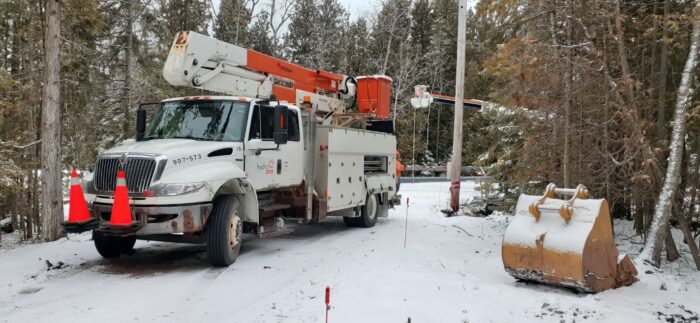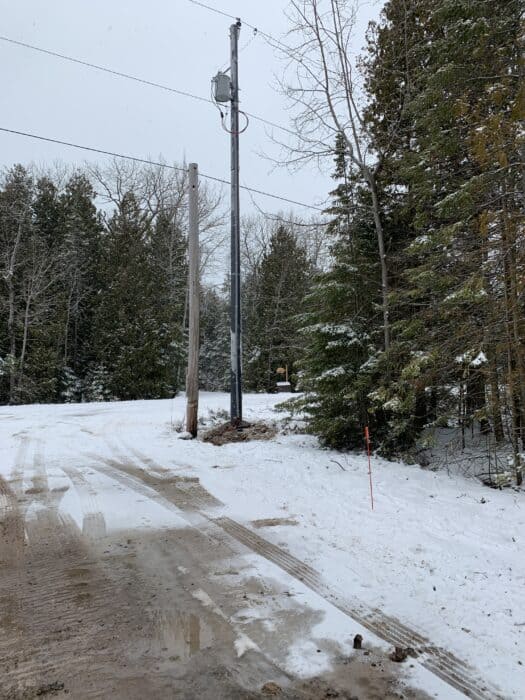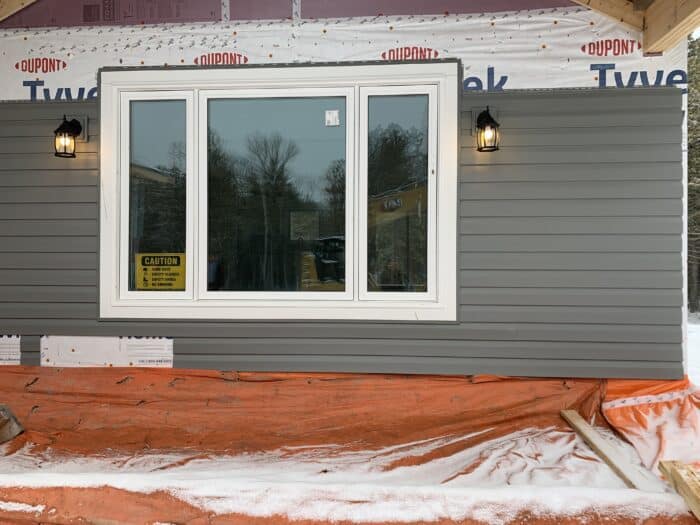We’ve learned a lot from our experience getting hydro to our new build. So, we thought it would be nice to share what we know now with you to help your experience go as smoothly as possible too. I figured it deserved its own post; you can still read the story of our installation if you like.
Note: What you’ll read below is what we’ve learned from our experience with Hydro One, our service provider for the Bruce Peninsula. Please be aware that your service provider may have different requirements and processes.

Don’t assume your setup will be the same as your neighbours’.
Often on our walks or driving around our neighbourhood, we’d stop to see how our neighbours’ hydro lines were run. Of course we had to make a number of assumptions because we didn’t want to trespass on any property. Most often we saw hydro lines run into flexible conduit and through the forest. The conduit was usually covered by concrete as far as we could see. It was either that or conduit and lines were run under a large mound at the side of the driveway.
When the time came for our installation, we were able to run ours along the side of the driveway as long as the driveway was built up enough to protect the conduit and hydro line. In fact, our site contractor was set up for a flexible conduit and concrete installation but after a conversation with the Hydro Field Office they had to switch to solid pipe and no concrete. Apparently in the time between our neighbours’ installations and ours, the regulations had changed or were in the process of changing and they wanted us to adhere to the new ones.

Factors That Will Affect Your Cost of Installation
Every lot, and every build is unique. It stands to reason that configurations and costs will be different. Here are some of the key factors that seem to affect your costs no matter where you are:
- Proximity to existing hydro lines – For example, we have a line running straight down our road but the homes one block over don’t. Depending how far down the road they are from the pole, they will require additional poles to be installed to get service to their lot. Some providers will cover the cost of one pole, the homeowner is responsible for the cost of the additional poles.
- Location to the nearest transformer – Sometimes, if your neighbour has a transformer and it’s close enough to your lot, your service provider can install your service as a secondary line. That was the case at our cottage but unfortunately not at our new home, so the cost of a new transformer was factored into the cost of our hydro hook-up.
- Size (amps) of the service required – This will depend on the size of your home, any outbuildings and other services that will need hydro. Your service provider will determine the service you would need based on the information you provide in your request for service. Here is a good article from Builders Ontario on how service size is determined. In a nutshell: under-servicing your home will affect your cost of installation but it will affect your lifestyle even more. Consider taking future plans (a well-equipped workshop, mechanic-worthy garage or hot tub for example) into account when getting your initial connection. If you think you’ll need a higher amperage in the future, request it on that first connection.
- Overhead vs. underground connection – Each option comes with it’s advantages and disadvantages. Factors affecting the cost of both are: how much and the type of wire, number of poles or length of conduit; if using conduit do you require concrete or not; direct burial or conduit. You might also factor in that overhead wires are more vulnerable to damage, require more maintenance and are less attractive, while underground service is virtually maintenance free and doesn’t affect the aesthetics of your home’s exterior. It seems that overhead wires are being offered less and that makes sense as the hydro company wouldn’t be called out for maintenance/repairs as much.
- Distance between the pole and the meter base – Some hydro providers will cover the cost of up to 100 feet of wire; any additional is at your expense. You can probably do the math from there 🙂
Have Your Utility Provider Do the Work
I understand that there’s a way to do some of the work yourself or to have your electrician do it. I’m not exactly sure how much you can do independently but other than saving – maybe – a few dollars, I don’t see the advantage. The way I see it is that if they’re doing the work they’ll have no complaints or reasons to delay on the day they show up to finish the connection.
Share Information Early
Be sure to provide as much information as possible in your request for service and any further communications with your Hydro Provider.
We had more influence than you’d think on the way our hydro line is run. While I felt my description was clear in my initial request it wasn’t until I provided illustrations that they listened. Then we were able to switch the location of our meter base from where they indicated on the layout to where it was on our house plans. To do that, I provided a copy of our electrical plan, our site plan, and pictures of the conduit already in place in the foundation. With that I kindly asked our case customer support person to reconsider the provided layout and they changed it.
Stay in touch with your Lines Customer Support person.
This person will be your main point of contact in the time between your request for service and scheduling. Don’t be a pest but keep the lines of communication open. If there are changes to the conditions on your project, let them know and ask them nicely to do the same. With the volume of new construction taking place, the front line workers are likely having to put up with a lot of stress and awful, yell-y people: don’t be those people! It never hurts to say a quick thank-you too.
Keep your builder and electrician in the loop throughout the process.
We had a few moments of confusion between our builder, our electrician and service provider’s responsibilities. Had it not been for an open line of communication (and me being okay with feeling silly for asking seemingly simple questions until I understood), I’m sure we wouldn’t have been ready in time. Let each person know what’s been done as things progress. This will give everyone the chance to be ready with fewer last-minute negotiations or rushes.
Don’t demand work if you’re not ready for it.
When you receive your hydro layout, there will be a section outlining your responsibilities. Whatever work you need to complete before the line is installed, be sure to take care of it promptly and let your provider know when it’s done. There’s a good chance your installation won’t come with a lot of notice so, if your contractor or electrician needs to do work and have it inspected before hydro shows up (and they probably do), make sure they do it.
It’s also quite helpful to have your ESA Inspection completed as early as possible. Our ESA inspections were completed before the hydro crew came to do our connection. This way they were able to do their complete scope of work without having to stop and wait for an inspector before energizing the line.
Start Early and Be Patient
This is probably the hardest part of all since this whole experience of building your new home is so exciting. As I mentioned in my post about our hydro installation, the process isn’t complex but there’s a lot riding on it and it can take a while to complete. Make your connection request as soon as you are able then work your plan as best you can. I placed our request for service on September 6th, 2022 and we received our hydro connection on January 22, 2023 – after a request for escalation (with cause), otherwise it would have been February 2.
Then, after all that, you too will be able to say “Light’s on, soon we’ll be home!”

Recent Posts
7 Totally Selfish Reasons to Choose Native Plants for Your Gardens
Grab a cup (or glass) of your favorite beverage, and let's delve into what I’ve learned so far about why it's incredibly important and wildly selfish to embrace landscaping with locally native...
Exploring the differences, benefits and drawbacks of Broadcast Sowing and Frost Seeding for Native plants.

